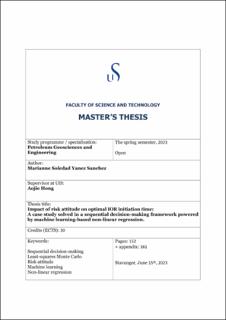| dc.description.abstract | The least-squares Monte Carlo algorithm (LSM) is an efficient approximate dynamic programming algorithm for solving sequential decision-making problems, leveraging regression. Previous studies have showcased the LSM workflow and linear regression in a sequential decision problem for optimizing the improved-oil-recovery (IOR) initiation and termination time, based on expected monetary value maximization as the decision criterion under risk neutrality.
In this work, risk attitude is introduced in the IOR optimization problem to assess the impact on the decisions. Risk behaviours are modelled using utility functions, and the optimal decision strategy is found by maximizing the expected utility. Since the utility functions introduce non-linearity, machine learning non-linear regression techniques are used in the LSM workflow to approximate the expected utilities.
Results suggest that risk-averse decision-makers prefer longer primary recovery lifetime compared to risk-neutral and risk-seeking decision-makers. This behaviour is attributed to the net present value (NPV) uncertainty related to the capital expenditure (CAPEX) incurred by switching to secondary recovery. Risk-averse decision-makers prefer shorter secondary recovery lifetime. This behaviour is attributed to the operational expenditure (OPEX) and production late-stage marginal cash inflow. The more risk-seeking the decision-maker is, the sooner they prefer to switch to secondary recovery, and the longer they would run the secondary recovery.
The value of the information increases as the decision-maker is more risk-seeking. The differences in the production lifetime decisions with the consideration of future information versus the decisions ignoring future information also increase as the decision-maker is more risk-seeking.
A change in the problem setting to a more marginal and uncertain case shows that risk-averse decision-makers would not run the project. Risk-neutral decision-makers would only run the project if future information were incorporated. This reinforces the importance of sequential decision-making, where value is created from information. Risk-seeking decision-makers would run the project with or without information.
The novelties and contributions from the present work include:
• Modelling, demonstration, and discussion of the impact of different risk attitudes on decisions.
• Selection and application of the best machine learning method for non-linear regression in the LSM approach.
• Demonstration of the value of considering future information in solving sequential decision-making problems. | |
